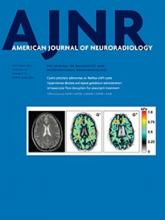Index by author
Chaitanya, G.
- EDITOR'S CHOICEFunctionalYou have accessSeizure Frequency Can Alter Brain Connectivity: Evidence from Resting-State fMRIR.D. Bharath, S. Sinha, R. Panda, K. Raghavendra, L. George, G. Chaitanya, A. Gupta and P. SatishchandraAmerican Journal of Neuroradiology October 2015, 36 (10) 1890-1898; DOI: https://doi.org/10.3174/ajnr.A4373
Resting-state fMRI data from 36 patients with hot-water epilepsy (18 with infrequent seizures) and 18 healthy age- and sex-matched controls were analyzed for seed-to-voxel connectivity. Patients in the frequent-seizure group had increased connectivity within the medial temporal structures and widespread areas of poor connectivity, including the default mode network. Seizure frequency can alter functional brain connectivity, which can be visualized by resting-state fMRI.
Chaudry, M.I.
- EDITOR'S CHOICENeurointerventionYou have accessMeta-Analysis of CSF Diversion Procedures and Dural Venous Sinus Stenting in the Setting of Medically Refractory Idiopathic Intracranial HypertensionS.R. Satti, L. Leishangthem and M.I. ChaudryAmerican Journal of Neuroradiology October 2015, 36 (10) 1899-1904; DOI: https://doi.org/10.3174/ajnr.A4377
The authors performed a PubMed search of all peer-reviewed articles from 1988–2014 for patients who underwent a procedure for medically refractory idiopathic intracranial hypertension. The CSF diversion procedure analysis included 435 patients. Postprocedure in this group, there was improvement of vision in 54%, headache in 80%, and papilledema in 70%. The dural venous sinus stenting analysis included 136 patients. In this group, after intervention, there was improvement of vision in 78%, headache in 83%, and papilledema in 97% of patients. The current clinical paradigm of CSF diversion first should be re-examined given the good technical success and low complication rates of stenting.
Cheng, S.
- FELLOWS' JOURNAL CLUBExtracranial VascularOpen AccessMR Elastography Can Be Used to Measure Brain Stiffness Changes as a Result of Altered Cranial Venous Drainage During Jugular CompressionA. Hatt, S. Cheng, K. Tan, R. Sinkus and L.E. BilstonAmerican Journal of Neuroradiology October 2015, 36 (10) 1971-1977; DOI: https://doi.org/10.3174/ajnr.A4361
The authors evaluated the effect of jugular compression on brain tissue stiffness and CSF flow by evaluating 9 volunteers, with and without jugular compression, with MR elastography and phase-contrast CSF flow imaging. The shear moduli of the brain tissue increased with the percentage of blood draining through the internal jugular veins during venous compression. Subjects who maintain venous drainage through the internal jugular veins during jugular compression have stiffer brains than those who divert venous blood through alternative pathways.
Choi, J.
- FELLOWS' JOURNAL CLUBAdult BrainYou have accessDifferentiation between Cystic Pituitary Adenomas and Rathke Cleft Cysts: A Diagnostic Model Using MRIM. Park, S.-K. Lee, J. Choi, S.-H. Kim, S.H. Kim, N.-Y. Shin, J. Kim and S.S. AhnAmerican Journal of Neuroradiology October 2015, 36 (10) 1866-1873; DOI: https://doi.org/10.3174/ajnr.A4387
This is a retrospective study that included 54 patients with a cystic pituitary adenoma and 28 patients with a Rathke cleft cyst who underwent MR imaging followed by surgery. Regression analysis showed that cystic pituitary adenomas and Rathke cleft cysts could be distinguished on the basis of the presence of a fluid-fluid level, septation, an off-midline location, and the presence of an intracystic nodule.
Choi, S.H.
- Adult BrainOpen AccessIndependent Poor Prognostic Factors for True Progression after Radiation Therapy and Concomitant Temozolomide in Patients with Glioblastoma: Subependymal Enhancement and Low ADC ValueR.-E. Yoo, S.H. Choi, T.M. Kim, S.-H. Lee, C.-K. Park, S.-H. Park, I.H. Kim, T.J. Yun, J.-H. Kim and C.H. SohnAmerican Journal of Neuroradiology October 2015, 36 (10) 1846-1852; DOI: https://doi.org/10.3174/ajnr.A4401
Choudhri, A.F.
- EDITORIAL PERSPECTIVESYou have accessSubspecialty Virtual Impact Factors within a Dedicated Neuroimaging JournalA.F. Choudhri and M. CastilloAmerican Journal of Neuroradiology October 2015, 36 (10) 1810-1813; DOI: https://doi.org/10.3174/ajnr.A4380
Cognard, C.
- NeurointerventionOpen AccessSingle-Layer WEBs: Intrasaccular Flow Disrupters for Aneurysm Treatment—Feasibility Results from a European StudyJ. Caroff, C. Mihalea, J. Klisch, C. Strasilla, A. Berlis, T. Patankar, W. Weber, D. Behme, E.A. Jacobsen, T. Liebig, S. Prothmann, C. Cognard, T. Finkenzeller, J. Moret and L. SpelleAmerican Journal of Neuroradiology October 2015, 36 (10) 1942-1946; DOI: https://doi.org/10.3174/ajnr.A4369
Cooke, D.L.
- EDITOR'S CHOICENeurointerventionYou have accessProgressive versus Nonprogressive Intracranial Dural Arteriovenous Fistulas: Characteristics and OutcomesS.W. Hetts, T. Tsai, D.L. Cooke, M.R. Amans, F. Settecase, P. Moftakhar, C.F. Dowd, R.T. Higashida, M.T. Lawton and V.V. HalbachAmerican Journal of Neuroradiology October 2015, 36 (10) 1912-1919; DOI: https://doi.org/10.3174/ajnr.A4391
Of 579 patients with intracranial dural arteriovenous fistulas, 545 had 1 fistula and 34 (5.9%) had enlarging, de novo, multiple, or recurrent fistulas. Of those 34 patients, 19 had progressive dural arteriovenous fistulas with de novo fistulas or fistula enlargement. Angioarchitectural correlates to chronically elevated intracranial venous pressures, such as venous sinus dilation and pseudophlebitic cortical venous pattern, were more common in progressive disease. Three young patients died despite endovascular, surgical, and radiosurgical treatments.
Cornelissen, B.M.W.
- NeurointerventionOpen AccessHemodynamic Differences in Intracranial Aneurysms before and after RuptureB.M.W. Cornelissen, J.J. Schneiders, W.V. Potters, R. van den Berg, B.K. Velthuis, G.J.E. Rinkel, C.H. Slump, E. VanBavel, C.B.L.M. Majoie and H.A. MarqueringAmerican Journal of Neuroradiology October 2015, 36 (10) 1927-1933; DOI: https://doi.org/10.3174/ajnr.A4385
Courbebaisse, G.P.
- NeurointerventionOpen AccessIntracranial Aneurysms: Wall Motion Analysis for Prediction of RuptureA.E. Vanrossomme, O.F. Eker, J.-P. Thiran, G.P. Courbebaisse and K. Zouaoui BoudjeltiaAmerican Journal of Neuroradiology October 2015, 36 (10) 1796-1802; DOI: https://doi.org/10.3174/ajnr.A4310








